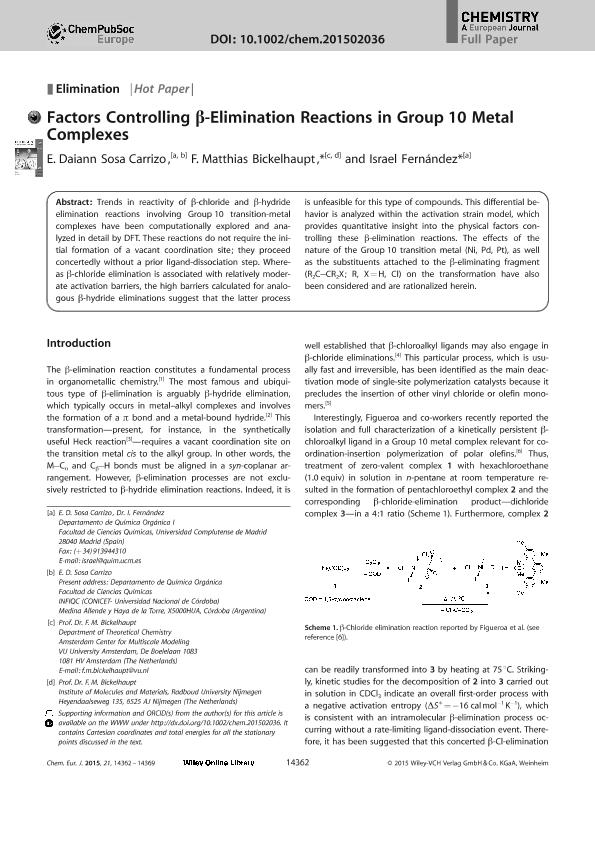Mostrar el registro sencillo del ítem
dc.contributor.author
Sosa Carrizo, Daiann

dc.contributor.author
Bickelhaupt, F. Matthias
dc.contributor.author
Fernandez Lopez, Israel

dc.date.available
2018-06-26T17:22:57Z
dc.date.issued
2015-10
dc.identifier.citation
Sosa Carrizo, Daiann; Bickelhaupt, F. Matthias; Fernandez Lopez, Israel; Factors Controlling β-Elimination Reactions in Group 10 Metal Complexes; Wiley VCH Verlag; Chemistry- A European Journal; 21; 41; 10-2015; 14362-14369
dc.identifier.issn
0947-6539
dc.identifier.uri
http://hdl.handle.net/11336/50105
dc.description.abstract
Trends in reactivity of β-chloride and β-hydride elimination reactions involving Group 10 transition-metal complexes have been computationally explored and analyzed in detail by DFT. These reactions do not require the initial formation of a vacant coordination site; they proceed concertedly without a prior ligand-dissociation step. Whereas β-chloride elimination is associated with relatively moderate activation barriers, the high barriers calculated for analogous β-hydride eliminations suggest that the latter process is unfeasible for this type of compounds. This differential behavior is analyzed within the activation strain model, which provides quantitative insight into the physical factors controlling these β-elimination reactions. The effects of the nature of the Group 10 transition metal (Ni, Pd, Pt), as well as the substituents attached to the β-eliminating fragment (R2C CR2X; R, X=H, Cl) on the transformation have also been considered and are rationalized herein. Dramatic differences: β-Chloride elimination reactions involving Group 10 metal polymerization catalysts (see scheme) do not require initial formation of a vacant coordination site and proceed with relatively moderate activation barriers. In sharp contrast, the computed barriers for the analogous β-hydride eliminations are prohibitively high.
dc.format
application/pdf
dc.language.iso
eng
dc.publisher
Wiley VCH Verlag

dc.rights
info:eu-repo/semantics/openAccess
dc.rights.uri
https://creativecommons.org/licenses/by-nc-sa/2.5/ar/
dc.subject
Activation Strain Model
dc.subject
Density Functional Calculations
dc.subject
Elimination
dc.subject
Group 10 Elements
dc.subject
Reactivity
dc.subject.classification
Otras Ciencias Químicas

dc.subject.classification
Ciencias Químicas

dc.subject.classification
CIENCIAS NATURALES Y EXACTAS

dc.title
Factors Controlling β-Elimination Reactions in Group 10 Metal Complexes
dc.type
info:eu-repo/semantics/article
dc.type
info:ar-repo/semantics/artículo
dc.type
info:eu-repo/semantics/publishedVersion
dc.date.updated
2018-05-04T21:44:47Z
dc.journal.volume
21
dc.journal.number
41
dc.journal.pagination
14362-14369
dc.journal.pais
Alemania

dc.journal.ciudad
Weinheim
dc.description.fil
Fil: Sosa Carrizo, Daiann. Universidad Complutense de Madrid; España. Consejo Nacional de Investigaciones Científicas y Técnicas. Centro Científico Tecnológico Conicet - Córdoba. Instituto de Investigaciones en Físico-química de Córdoba. Universidad Nacional de Córdoba. Facultad de Ciencias Químicas. Instituto de Investigaciones en Físico-química de Córdoba; Argentina
dc.description.fil
Fil: Bickelhaupt, F. Matthias. Vrije Universiteit Amsterdam; Países Bajos. Radboud Universiteit Nijmegen; Países Bajos
dc.description.fil
Fil: Fernandez Lopez, Israel. Universidad Complutense de Madrid; España
dc.journal.title
Chemistry- A European Journal

dc.relation.alternativeid
info:eu-repo/semantics/altIdentifier/doi/http://dx.doi.org/10.1002/chem.201502036
dc.relation.alternativeid
info:eu-repo/semantics/altIdentifier/url/https://onlinelibrary.wiley.com/doi/abs/10.1002/chem.201502036
Archivos asociados
